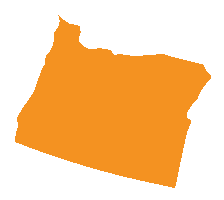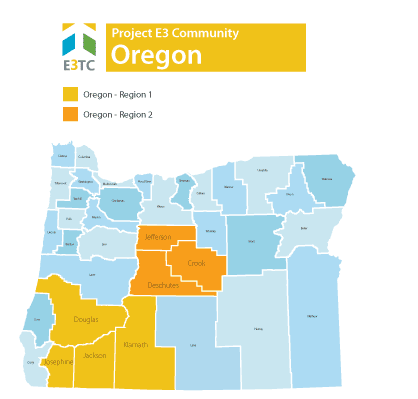Oregon was chosen as a targeted community through the Vocational Rehabilitation Technical Assistance Center: Targeted Communities (VR-TAC-TC) or Project E3. Project E3 partnered with State VR Agencies and local community partners to improve outreach and employment-related services to underserved people with disabilities in this community.

Oregon is in the Pacific Northwest on the West Coast. It is primarily rural state and is one of the most geographically diverse states with volcanoes, dense evergreen and mixed forests, many bodies of water, high deserts, and semi-arid shrub lands. The generally mild climate and variety of natural landscapes makes Oregon a beautiful and popular place to visit.
Oregon’s economy is mainly driven by agriculture, fishing, and hydroelectric power. It is also one of the largest timber producers in the United States.
Targeted Communities
The state-federal vocational rehabilitation system in Oregon faced many challenges as it strove to serve people with significant disabilities and promote competitive integrated employment. Project E3 provided intensive technical assistance to two regions of the state:

Key Information:
Rural Population
National rate = 6.3%
23 of Oregon’s 36 counties are non-metropolitan
Visual Impairment
Unemployment
Employment rate for people without a vision disability= 78.1%
Disability Rate
Poverty Rate
Targeted Populations
These populations were characterized as:
Primary Challenges for Targeted Populations
Some of the challenges of this population in Oregon included:
Key Strategies to Address Barriers
Following are some of the key strategies developed and implemented to address the targeted populations' challenges and barriers to employment.
Community Based Participatory Research (CBPR): To understand a community’s issues and concerns, one needs data and information both supplied by common data sources and interpreted by the community to better understand their issues and possible solutions to those issues. CBPR’s methodology is predicated on deep and extensive community involvement in the identification of issues and concerns and in the resolution of those issues and concerns.
Transportation: Transportation is regularly cited as the number one barrier for persons with disabilities. Working with Oregon, Kentucky developed a series of transportation modules and successful practices which help address the issue. The transportation modules were tailored to the needs and issues in Oregon.
Integrated Resource Teams: To overcome shortage of resources, overlapping services, lack of information, and coordinated planning, Integrated Resource Teams (IRTs) are an excellent way to structure collaborative working arrangements as well as consider options for the blending and braiding of services and funding. IRT membership depends on the locale and existing working relationships and can include Vocational Rehabilitation, education, social services, Workforce, faith-based organizations, mental health agencies, veteran’s agencies, etc. Oregon received on-going training and support on the use of IRT in their daily work.
Community Outreach and Orientation: Community buy-in and support needs constant attention as community members change and new members are added. Oregon actively engaged Vocational Rehabilitation and community partners in regular discussions of issues and common methods to help resolve those issues. The pandemic caused a switch to virtual meetings.
Oregon Overview PowerPoint Presentation
Project Outcomes
Project E3 provided Oregon’s state Vocational Rehabilitation agencies and their partners with the skills and competencies needed to effectively and efficiently address barriers to competitive integrated employment and community integration encountered by persons with disabilities in these regions.
Our specific goals for this project were to:
We will leverage promising practices, knowledge, and experience gained from this project to expand employment opportunities for individuals with disabilities from underserved and economically disadvantaged populations throughout Oregon and across the United States.
Continuation and Sustainability Plan
Tools and Resources
Transportation Resources
Learn more about Transition
- Transition 101 Module: What we all need to know about transition
- Transition 201 Module: The Expanded Core Curriculum
- Benefits Workbook: How will employment impact benefits PDF
Assistive Technology
- Devices and technology for employment, education, and independence
More Information
For further information about the Oregon community activities - visit their project webpage or contact:

Christina Espinosa Bard, MRC, CRC
Director, Community Education
Human Development Institute
Ctespinosa@uky.edu


